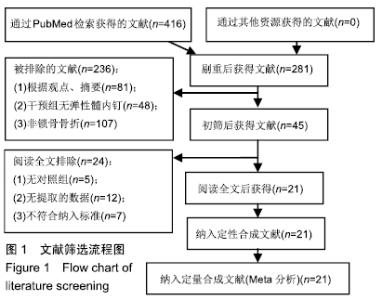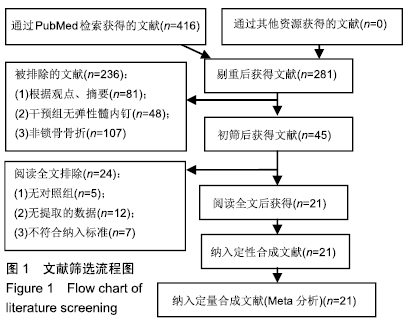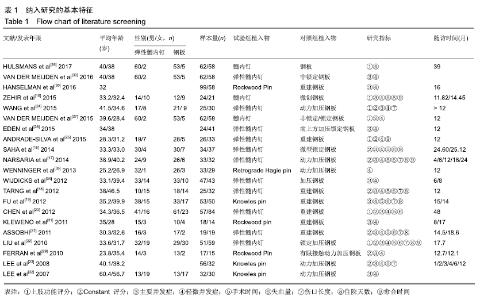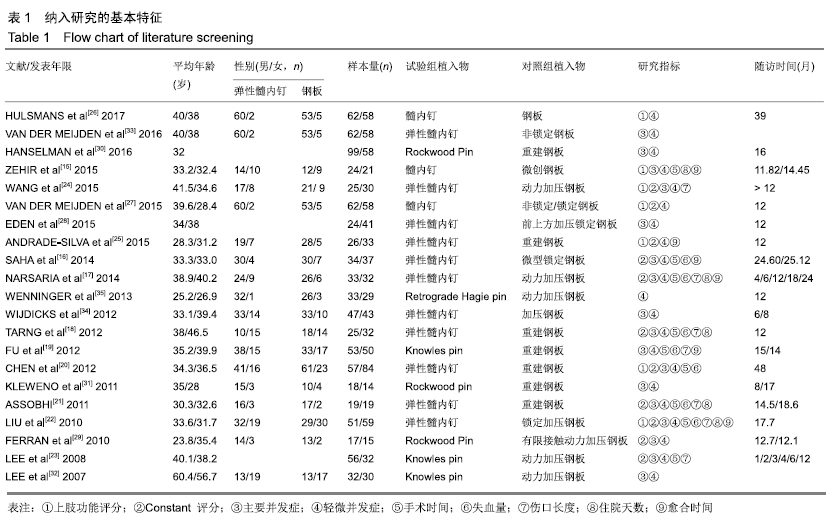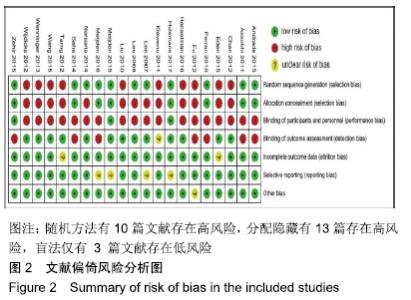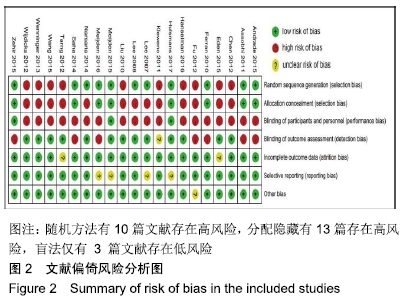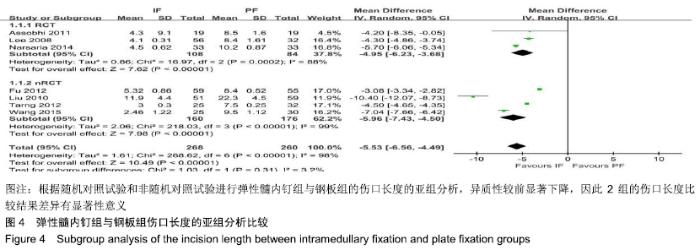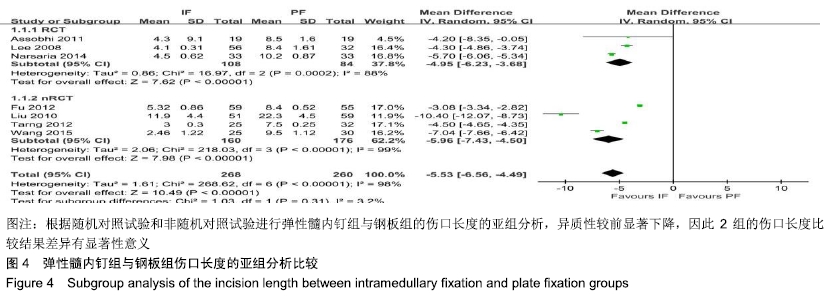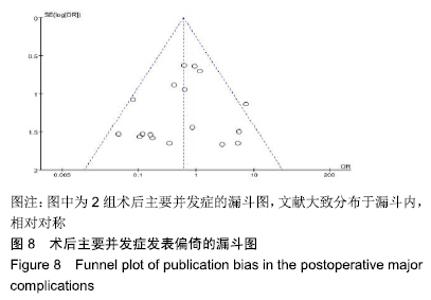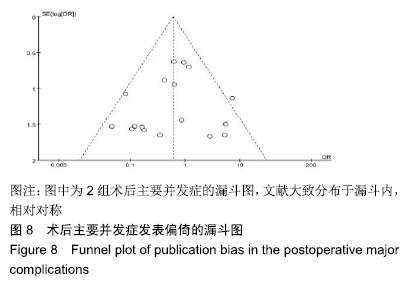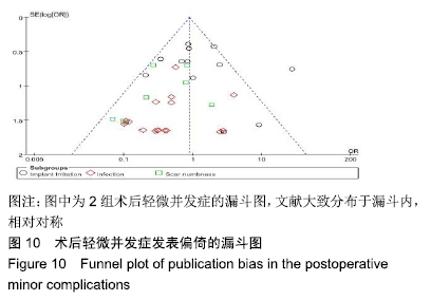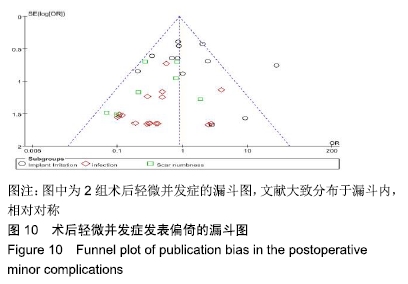Chinese Journal of Tissue Engineering Research ›› 2020, Vol. 24 ›› Issue (6): 947-955.doi: 10.3969/j.issn.2095-4344.2455
Previous Articles Next Articles
Intramedullary fixation versus plate fixation in the treatment of displaced mid-shift clavicle fractures: a meta-analysis
Liang Jie1, Xiang Feifan1, Yang Kun2, Sun Yuanlin3, Zhou Wei1, Xiang Yong1, Yang Yunkang1
- 1Department of Bone and Joint Surgery, the Affiliated Hospital of Southwest Medical University, Luzhou 646000, Sichuan Province, China; 2Department of Orthopedics, Luzhou People’s Hospital, Luzhou 646000, Sichuan Province, China; 3the First People’s Hospital of Yibin, Yibin 644000, Sichuan Province, China
-
Received:2019-06-11Revised:2019-06-12Accepted:2019-07-10Online:2020-02-28Published:2020-01-18 -
Contact:Yang Yunkang, MD, Professor, Department of Bone and Joint Surgery, the Affiliated Hospital of Southwest Medical University, Luzhou 646000, Sichuan Province, China -
About author:Liang Jie, Master candidate, Department of Bone and Joint Surgery, the Affiliated Hospital of Southwest Medical University, Luzhou 646000, Sichuan Province, China -
Supported by:the Project of the Affiliated Hospital of Southwest Medical University, No. 2017-PT-47; the Project of Southwest Medical University, No. 2017-ZRQN-129
CLC Number:
Cite this article
Liang Jie, Xiang Feifan, Yang Kun, Sun Yuanlin, Zhou Wei, Xiang Yong, Yang Yunkang. Intramedullary fixation versus plate fixation in the treatment of displaced mid-shift clavicle fractures: a meta-analysis[J]. Chinese Journal of Tissue Engineering Research, 2020, 24(6): 947-955.
share this article
Add to citation manager EndNote|Reference Manager|ProCite|BibTeX|RefWorks
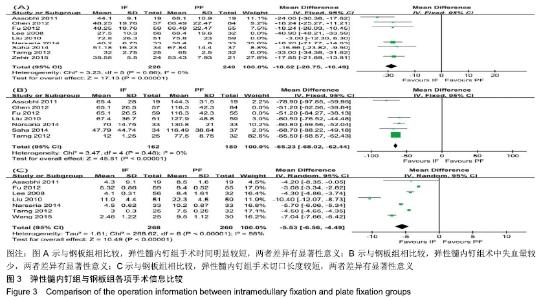
2.3 Meta分析结果 2.3.1 关于手术的Meta分析结果 纳入研究的9篇文献报道了弹性髓内钉组和钢板组的手术时间[15-23]。把9篇文献行Meta分析,异质性检验提示纳入研究的文献具有异质性(I2=95%),宜采用随机效应模型。进行敏感性分析减少异质性,3篇文献被剔除[18,22-23]。Meta分析结果显示2组手术方式的手术时间差异有显著性意义,弹性髓内钉组的手术时间明显短于钢板组[MD=-18.62,95%CI(-20.75,-16.49),P < 0.000 01,I2=0%],见图3A。 纳入研究的7篇文献报道了弹性髓内钉组和钢板组的术中失血情况[16-22]。进行Meta分析,异质性检验提示纳入研究的文献具有异质性(I2=53%),采用随机效应模型。进行敏感性分析减少异质性,2篇文献被排除[19-20]。分析结果显示2组手术方式在术中失血量方面差异有显著性意义,且弹性髓内钉组的术中血液量丢失明显低于钢板组[MD=-65.23,95%CI(-68.02,-62.44),P < 0.000 01,I2=0%],见图3B。 "
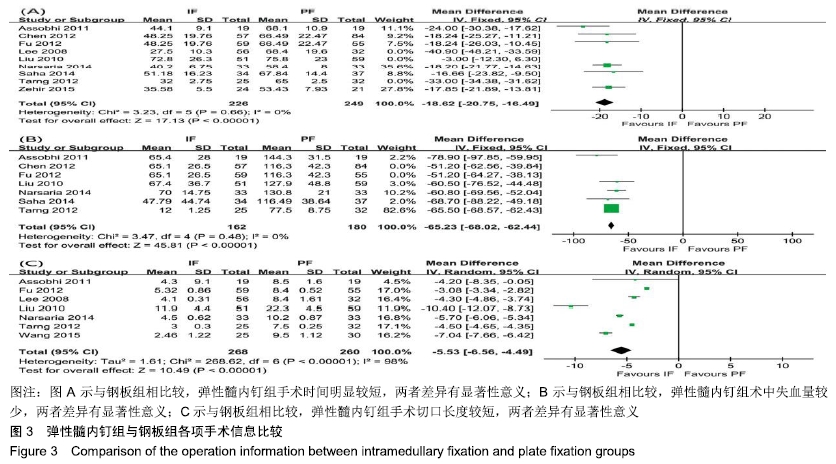
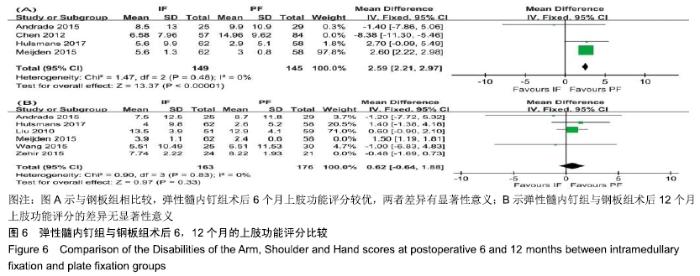
2.3.3 上肢功能评分的分析 纳入研究的4篇文献报道了术后6个月的弹性髓内钉组和钢板组的上肢功能评分[20,25-27]。拿4篇文献进行Meta分析时,异质性检验提示纳入研究的文献具有异质性(I2=95%)。经过敏感性分析后,1篇文献被排除在外[20],分析结果提示2组上肢功能评分比较差异有显著性意义,弹性髓内钉组的上肢功能评分明显好于钢板组[MD=2.59,95%CI(2.21,2.97),P < 0.000 01,I2=0%],见图6A。 纳入文献研究的6篇报道中提到了报道术后12个月的弹性髓内钉组和钢板组的上肢功能评分[15,22,24-27]。当6篇文献进行Meta分析时,异质性检验提示纳入研究的文章具有异质性(I2=58%)。经敏感性分析后,2篇文章被排除在外[15,27],分析结果提示在术后12个月后两组的上肢功能评分差异无显著性意义,即2组上肢功能评分差异无显著性意义[MD=0.62,95%CI(-0.64,1.88),P=0.33,I2=0%],见图6B。 "
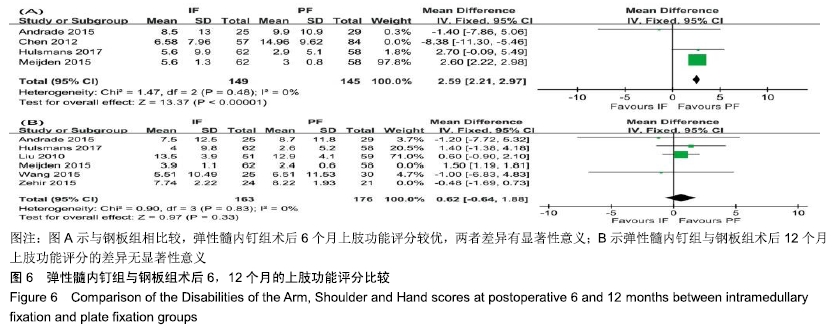
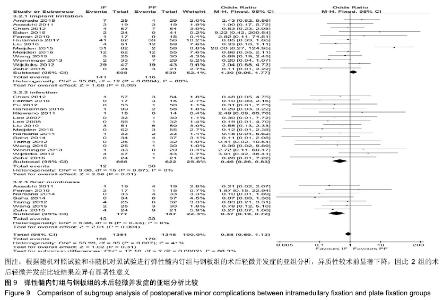
纳入研究的21篇文献提到了弹性髓内钉组和钢板组的术后轻微并发症[15-35]。对文献中统计的数据进行Meta分析时,异质性检验提示纳入研究的文献具有异质性(I2= 63%,此数据在未进行亚组分析时由Revman软件得出的结果)。经过亚组分析后,结果显示,在弹性髓内钉组和钢板组中,关于轻微并发症的发生率差异有显著性意义。 在其亚组植入物刺激反应分析中,Meta分析结果为:OR=1.30,95%CI(0.96,1.77),P=0.09,I2=66%。在其亚组感染中,Meta分析结果为:OR=0.46,95%CI(0.26,0.83),P=0.01,I2=0%。在其亚组术后瘢痕麻木分析中,Meta分析结果为:OR=0.37,95%CI(0.19,0.72),P=0.000 4,I2=0%,见图9。术后轻微并发症的漏斗图结果显示无发表偏倚,见图10。 "
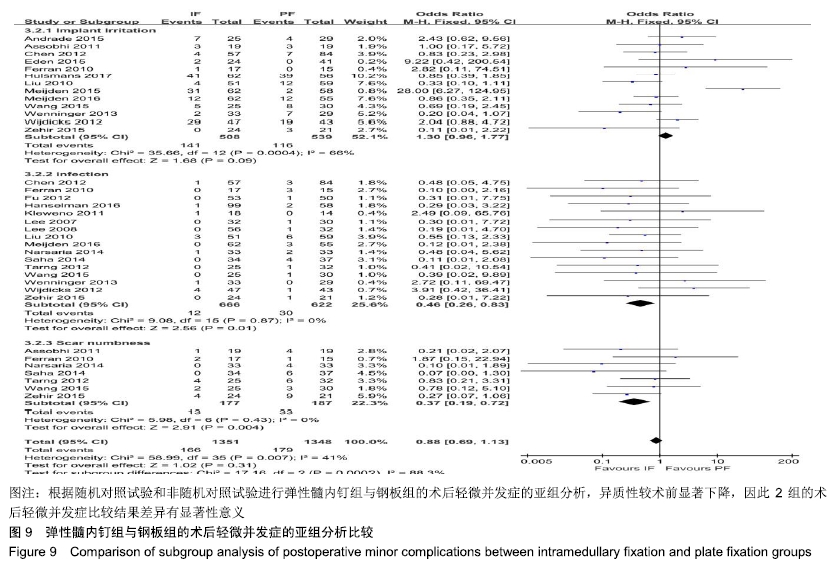
| [1] KIHLSTROM C, MOLLER M, LONN K, et al. Clavicle fractures: epidemiology, classification and treatment of 2 422 fractures in the Swedish Fracture Register; an observ ational study. BMC Musculoskelet Disord. 2017;18(1):82. [2] BHATTACHARYYA R, JAYARAM PR, HOLLIDAY R, et al. The virtual fracture clinic: Reducing unnecessary review of clavicle fractures. Injury. 2017;48(3):720-723. [3] SMEEING DP, VAN DER VEN DJ, HIETBRINK F, et al. Surgical versus nonsurgical treatment for midshaft clavicle fractures in patients aged 16 years and older: a systematic review, meta-analysis, and comparison of randomized controlled trials and observational studies. Am J Sports Med. 2016. [4] NAVEEN BM, JOSHI GR, HARIKRISHNAN B. Management of mid-shaft clavicular fractures: comparison between non-operative treatment and plate fixation in 60 patients. Strategies Trauma Limb Reconstr. 2017;12(1):11-18. [5] ROPARS M, THOMAZEAU H, HUTEN D. Clavicle fractures. Orthop Traumatol Surg Res. 2017;103(1 Supplement):S53-S59. [6] GUZMAN-GUEVARA J, LOPEZ-CAZARES G, BARRAGAN- HERVELLA RG, et al. Evaluation of patients with humeral midshaft fractures treated with DCP plate vs. intramedullary nail UHN. Rev Med Inst Mex Seguro Soc. 2016;54 Suppl 3:S270-s274. [7] NI M, NIU W, WONG DW, et al. Finite element analysis of locking plate and two types of intramedullary nails for treating mid-shaft clavicle fractures. Injury. 2016;47(8):1618-1623. [8] ZENG L, WEI H, LIU Y, et al. Titanium elastic nail (TEN) versus reconstruction plate repair of midshaft clavicular fractures: A finite element study. PLoS One. 2015;10(5): e0126131. [9] CHUNG HJ, HONG KJ, KIM DS. Biomechanical properties of titanium elastic nail applied to a cadaveric clavicle model. Orthop Traumatol Surg Res. 2015;101(7):823-826. [10] LI Y, HELVIE P, FARLEY FA, et al. Complications after plate fixation of displaced pediatric midshaft clavicle fractures. J Pediatr Orthop. 2016. [11] BALARAMAN R, SATHISH KUMAR R, SRI KRISHNA SANDEEP S, et al. Short term functional outcome of displaced midshaft clavicle fractures treated with TENS nailing. Res J Pharmaceutical Biol Chem Sci. 2015;6(2):2011-2016. [12] BI H, WANG Y, XIONG Q, et al. Minimally invasive fixation of midclavicular fractures with threaded elastic intramedullary nails. Eur J Orthop Surg Traumatol. 2015;25(5):833-840. [13] LU CC, LIU PC, HUANG SH, et al. Complications and technical pitfalls of titanium elastic nail fixation for midclavicular fractures. Orthopedics. 2014;37(4):e377-e383. [14] ASADOLLAHI S, HAU RC, PAGE RS, et al. Complications associated with operative fixation of acute midshaft clavicle fractures. Injury. 2016; 47(6):1248-1252. [15] ZEHIR S, ZEHIR R, SAHIN E, et al. Comparison of novel intramedullary nailing with mini-invasive plating in surgical fixation of displaced midshaft clavicle fractures. Arch Orthop Trauma Surg. 2015; 135(3):339-344. [16] SAHA P, DATTA P, AYAN S, et al. Plate versus titanium elastic nail in treatment of displaced midshaft clavicle fractures: A comparative study. Indian J Orthop. 2014;48(6):587-593. [17] NARSARIA N, SINGH AK, ARUN GR, et al. Surgical fixation of displaced midshaft clavicle fractures: elastic intramedullary nailing versus precontoured plating. J Orthop Traumatol. 2014;15(3):165-171. [18] TARNG YW, YANG SW, FANG YP, et al. Surgical management of uncomplicated midshaft clavicle fractures: a comparison between titanium elastic nails and small reconstruction plates. J Shoulder Elbow Surg. 2012;21(6):732-740. [19] FU TH, TAN BL, LIU HC, et al. Anatomical reduction for treatment of displaced midshaft clavicular fractures: Knowles pinning vs. reconstruction plating. Orthopedics. 2012;35(1):e23-30. [20] CHEN YF, WEI HF, ZHANG C, et al. Retrospective comparison of titanium elastic nail (TEN) and reconstruction plate repair of displaced midshaft clavicular fractures. J Shoulder Elbow Surg. 2012;21(4):495-501. [21] ASSOBHI JE. Reconstruction plate versus minimal invasive retrograde titanium elastic nail fixation for displaced midclavicular fractures. J Orthop Traumatol. 2011;12(4):185-192. [22] LIU HH, CHANG CH, CHIA WT, et al. Comparison of plates versus intramedullary nails for fixation of displaced midshaft clavicular fractures. J Trauma. 2010;69(6):E82-87. [23] LEE YS, HUANG HL, LO TY, et al. Surgical treatment of midclavicular fractures: a prospective comparison of Knowles pinning and plate fixation. Int Orthop. 2008;32(4):541-545. [24] WANG YC, FU YC, CHOU SH, et al. Titanium Elastic Nail versus plate fixation of displaced midshaft clavicle fractures: A retrospective comparison study. Kaohsiung J Med Sci. 2015;31(9):473-479. [25] ANDRADE-SILVA FB, KOJIMA KE, JOERIS A, et al. Single, superiorly placed reconstruction plate compared with flexible intramedullary nailing for midshaft clavicular fractures: A prospective, randomized controlled trial. J Bone Joint Surg Am. 2015;97(8):620-626. [26] HULSMANS MH, VAN HEIJL M, HOUWERT RM, et al. High Irritation and Removal Rates After Plate or Nail Fixation in Patients With Displaced Midshaft Clavicle Fractures. Clin Orthop Relat Res. 2017; 475(2):532-539. [27] VAN DER MEIJDEN OA, HOUWERT RM, HULSMANS M, et al. Operative treatment of dislocated midshaft clavicular fractures: plate or intramedullary nail fixation? A randomized controlled trial. J Bone Joint Surg Am. 2015;97(8):613-619. [28] EDEN L, ZIEGLER D, GILBERT F, et al. Significant pain reduction and improved functional outcome after surgery for displaced midshaft clavicular fractures. J Orthop Surg Res. 2015;10:190. [29] FERRAN NA, HODGSON P, VANNET N, et al. Locked intramedullary fixation vs plating for displaced and shortened mid-shaft clavicle fractures: A randomized clinical trial. J Shoulder Elbow Surg. 2010; 19(6):783-789. [30] HANSELMAN AE, MURPHY TR, BAL GK, et al. Operative Cost Comparison: Plating Versus Intramedullary Fixation for Clavicle Fractures. Orthopedics. 2016;39(5):e877-882. [31] KLEWENO CP, JAWA A, WELLS JH, et al. Midshaft clavicular fractures: comparison of intramedullary pin and plate fixation. J Shoulder Elbow Surg. 2011;20(7):1114-1117. [32] LEE YS, LIN CC, HUANG CR, et al. Operative treatment of midclavicular fractures in 62 elderly patients: knowles pin versus plate. Orthopedics. 2007;30(11):959-964. [33] VAN DER MEIJDEN OA, HOUWERT RM, WIJDICKS FG, et al. Introducing the Surgical Therapeutic Index in trauma surgery: an assessment tool for the benefits and risks of operative fracture treatment strategies. J Shoulder Elbow Surg. 2016;25(12):2005-2010. [34] WIJDICKS FJ, HOUWERT M, DIJKGRAAF M, et al. Complications after plate fixation and elastic stable intramedullary nailing of dislocated midshaft clavicle fractures: a retrospective comparison. Int Orthop. 2012;36(10):2139-2145. [35] WENNINGER JJ JR, DANNENBAUM JH, BRANSTETTER JG, et al. Comparison of complication rates of intramedullary pin fixation versus plating of midshaft clavicle fractures in an active duty military population. J Surg Orthop Adv. 2013;22(1):77-81. [36] POSTACCHINI F, GUMINA S, DE SANTIS P, et al. Epidemiology of clavicle fractures. J Shoulder Elbow Surg. 2002; 11(5): 452-456. [37] 成军,赵渝,张矛,等,锁骨下动脉损伤开放手术与腔内手术治疗的比较[J].第三军医大学学报,2011,33(17):1872-1874. [38] ERSEN A, ATALAR AC, BIRISIK F, et al.Comparison of simple arm sling and figure of eight clavicular bandage for midshaft clavicular fractures: a randomised controlled study. Bone Joint J.2015;97-B(11): 1562-1565. [39] ROBINSON CM, COURT-BROWN CM, MC QUEEN MM, et al. Estimating the risk of nonunion following nonoperative treatment of a clavicular fracture. J Bone Joint Surg Am. 2004;86-A(7):1359-1365. [40] JERAY KJ. Acute midshaft clavicular fracture. J Am Acad Orthop Surg. 2007;15(4):239-248. [41] PECCI M, KREHER JB. Clavicle fractures. Am Fam Physician. 2008; 77(1): 65-70. [42] CANADINA ORTHOPAEDIC TRAUMA SOCIETY. Nonoperative treatment compared with plate fixation of displaced midshaft clavicular fractures.A multicenter randomized clinical trial. J Bone Joint Surg Am. 2007;89(1):1-10. [43] 李浪,陈龙,邢飞,项舟.手术与非手术治疗锁骨中段骨折的Meta分析[J].中国循证医学杂志,2018,18(5):489-497. [44] 徐士安.改良双克氏针治疗锁骨骨折应用体会[J].当代医学,2007,13(13): 133-134. [45] 张谢卓,刘利国,哈斯鲁,等.重建钢板与克氏针置入内固定修复锁骨骨折的Meta分析[J].中国组织工程研究, 2015,19(44):7209-7216. [46] SARAF H, KASTURE S. Closed vs open nailing for displaced middle third fracture of clavicle. Does it matter? J Clin Orthop Trauma. 2016;7 Supplement 2:161-165. [47] SOHN HS, KIM WJ, SHON MS. Comparison between open plating versus minimally invasive plate osteosynthesis for acute displaced clavicular shaft fractures. Injury. 2015;46(8):1577-1584. [48] XIAO H, GAO H, ZHENG T, et al. Plate fixation versus intramedullary fixation for midshaft clavicle fractures: Meta-analysis of complications and functional outcomes. J Int Med Res. 2016;44(2):201-215. [49] HUSSAIN N, SERMER C, PRUSICK PJ, et al. Intramedullary Nailing Versus Plate Fixation for the Treatment Displaced Midshaft Clavicular Fractures: A Systematic Review and Meta-Analysis. Sci Rep. 2016; 6:34912. [50] GAO Y, CHEN W, LIU YJ, et al. Plating versus intramedullary fixation for mid-shaft clavicle fractures: a systemic review and meta-analysis. Peer J. 2016;4:e1540. [51] ZHANG B, ZHU Y, ZHANG F, et al.Meta-analysis of plate fixation versus intramedullaryfixation for the treatment of mid-shaft clavicle fractures.Scand J Trauma Resusc Emerg Med.2015;23:27. [52] XIAO YP, SHU DP, BEI MJ, et al. The clinical application of a novelmethod of internal fixation for femoral neck fractures-dynamic loc-king compression system. J Orthop Surg Res. 2018;13(1):131. [53] 郑亦静,洪建军,程涛,等. 微创经皮锁定钢板与切开复位重建钢板内固定在治疗锁骨骨折中的疗效比较[J].中华手外科杂志2013,29(4):225-227. [54] 杨冰.微创经皮锁定钢板治疗锁骨骨折的疗效观察[J].内蒙古医学杂志, 2018,50(6):719-720. [55] FUGLESANG HFS, OKSUM MA, WIKERØY AKB. Mini-invasive intramedullary fixation of displaced midshaft clavicle fractures with an elastic titanium nail. JBJS Essent Surg Tech. 2018;8(2):e16. |
| [1] | Hu Kai, Qiao Xiaohong, Zhang Yonghong, Wang Dong, Qin Sihe. Treatment of displaced intra-articular calcaneal fractures with cannulated screws and plates: a meta-analysis of 15 randomized controlled trials [J]. Chinese Journal of Tissue Engineering Research, 2021, 25(9): 1465-1470. |
| [2] | Huang Dengcheng, Wang Zhike, Cao Xuewei. Comparison of the short-term efficacy of extracorporeal shock wave therapy for middle-aged and elderly knee osteoarthritis: a meta-analysis [J]. Chinese Journal of Tissue Engineering Research, 2021, 25(9): 1471-1476. |
| [3] | Xu Feng, Kang Hui, Wei Tanjun, Xi Jintao. Biomechanical analysis of different fixation methods of pedicle screws for thoracolumbar fracture [J]. Chinese Journal of Tissue Engineering Research, 2021, 25(9): 1313-1317. |
| [4] | Zhang Tongtong, Wang Zhonghua, Wen Jie, Song Yuxin, Liu Lin. Application of three-dimensional printing model in surgical resection and reconstruction of cervical tumor [J]. Chinese Journal of Tissue Engineering Research, 2021, 25(9): 1335-1339. |
| [5] | Du Xiupeng, Yang Zhaohui. Effect of degree of initial deformity of impacted femoral neck fractures under 65 years of age on femoral neck shortening [J]. Chinese Journal of Tissue Engineering Research, 2021, 25(9): 1410-1416. |
| [6] | Zhang Shangpu, Ju Xiaodong, Song Hengyi, Dong Zhi, Wang Chen, Sun Guodong. Arthroscopic suture bridge technique with suture anchor in the treatment of acromioclavicular dislocation [J]. Chinese Journal of Tissue Engineering Research, 2021, 25(9): 1417-1422. |
| [7] | Zhou Jihui, Li Xinzhi, Zhou You, Huang Wei, Chen Wenyao. Multiple problems in the selection of implants for patellar fracture [J]. Chinese Journal of Tissue Engineering Research, 2021, 25(9): 1440-1445. |
| [8] | Chen Junming, Yue Chen, He Peilin, Zhang Juntao, Sun Moyuan, Liu Youwen. Hip arthroplasty versus proximal femoral nail antirotation for intertrochanteric fractures in older adults: a meta-analysis [J]. Chinese Journal of Tissue Engineering Research, 2021, 25(9): 1452-1457. |
| [9] | Chen Jinping, Li Kui, Chen Qian, Guo Haoran, Zhang Yingbo, Wei Peng. Meta-analysis of the efficacy and safety of tranexamic acid in open spinal surgery [J]. Chinese Journal of Tissue Engineering Research, 2021, 25(9): 1458-1464. |
| [10] | Wang Yongsheng, Wu Yang, Li Yanchun. Effect of acute high-intensity exercise on appetite hormones in adults: a meta-analysis [J]. Chinese Journal of Tissue Engineering Research, 2021, 25(8): 1305-1312. |
| [11] | Kong Desheng, He Jingjing, Feng Baofeng, Guo Ruiyun, Asiamah Ernest Amponsah, Lü Fei, Zhang Shuhan, Zhang Xiaolin, Ma Jun, Cui Huixian. Efficacy of mesenchymal stem cells in the spinal cord injury of large animal models: a meta-analysis [J]. Chinese Journal of Tissue Engineering Research, 2021, 25(7): 1142-1148. |
| [12] | Xu Yulin, Shen Shi, Zhuo Naiqiang, Yang Huilin, Yang Chao, Li Yang, Zhao Heng, Zhao Lu. Biomechanical comparison of three different plate fixation methods for acetabular posterior column fractures in standing and sitting positions [J]. Chinese Journal of Tissue Engineering Research, 2021, 25(6): 826-830. |
| [13] | Hou Guangyuan, Zhang Jixue, Zhang Zhijun, Meng Xianghui, Duan Wen, Gao Weilu. Bone cement pedicle screw fixation and fusion in the treatment of degenerative spinal disease with osteoporosis: one-year follow-up [J]. Chinese Journal of Tissue Engineering Research, 2021, 25(6): 878-883. |
| [14] | He Li, Tian Wei, Xu Song, Zhao Xiaoyu, Miao Jun, Jia Jian. Factors influencing the efficacy of lumbopelvic internal fixation in the treatment of traumatic spinopelvic dissociation [J]. Chinese Journal of Tissue Engineering Research, 2021, 25(6): 884-889. |
| [15] | Yang Weiqiang, Ding Tong, Yang Weike, Jiang Zhengang. Combined variable stress plate internal fixation affects changes of bone histiocyte function and bone mineral density at the fractured end of goat femur [J]. Chinese Journal of Tissue Engineering Research, 2021, 25(6): 890-894. |
| Viewed | ||||||
|
Full text |
|
|||||
|
Abstract |
|
|||||
